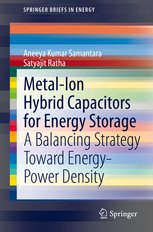
Название: Metal-Ion Hybrid Capacitors for Energy Storage: A Balancing Strategy Toward Energy-Power Density
Автор: Aneeya Kumar Samantara, Satyajit Ratha
Издательство: Springer
Год: 2020
Страниц: 115
Размер: 10.88 МБ
Формат: PDF
Язык: English
Rapid growth in the research and development of clean energy storage techniques has yielded a significant number of electrochemically active compounds/materials possessing enormous potential to facilitate the fabrication of next generation devices such as the supercapacitor. This Brief describes recent progress in the field of metal-ion based hybrid electrical energy storage devices, with emphasis on the effect of different metal ions and other constituent components on the overall electrochemical performance of battery-supercapacitor hybrids (BSHs).
Although significant efforts have been made to create an effective electrical energy storage system that would have the energy density of a battery and the power density of a supercapacitor, persistent challenges still lie in combining these two altogether different systems to form a cost-effective and safe storage device. Detailed comparisons of output performance and longevity (in terms of cyclic stability) are provided, including device fabrication cost and safety.
Of the several proposed schematics/prototypes, hybrid supercapacitors, with both carbon-based EDLC electrode and pure faradic (battery type) electrode can work in tandem to yield high energy densities with little degradation in specific power. As a promising electric energy storage device, supercapacitors address several critical issues in various fields of applications from miniaturized electronic devices and wearable electronics to power hungry heavy automobiles. Depending on the electrode configuration and other controlling parameters, these BSHs can have contrasting performance statistics. Metal ion BSHs such as Li+, Na+, Mg+2, Zn+2 etc., acid-alkaline BSHs, and redox electrolyte based BSHs all represent recent approaches, with BSHs based on metal ions, particularly Lithium, of particular interest because of the extreme popularity of Li-ion based batteries. This book is written for a broad readership of graduate students and academic and industrial researchers who are concerned with the growth and development of sustainable energy systems where efficient and cost-effective storage is key.